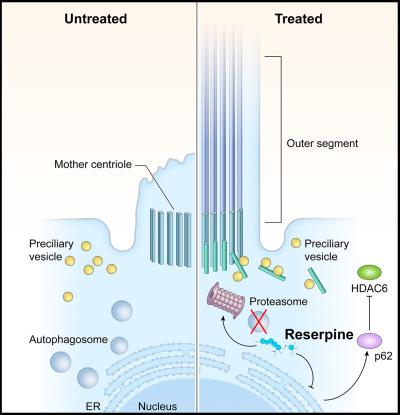
In LCA10, CEP290 mutations lead to defects in the photoreceptor outer segment. Consequently, the building blocks of the primary cilium accumulate in the photoreceptors, which activates autophagy (shown left, untreated). Reserpine restores the balance between autophagy and the ubiquitin-proteasome system histone deacetylase 6 and improves primary cilium assembly. Holly Y. Chen, Ph.D., NEI
A National Eye Institute-led team has identified a compound already approved by the U.S. Food and Drug Administration that keeps light-sensitive photoreceptors alive in three models of Leber congenital amaurosis type 10 (LCA 10), an inherited retinal ciliopathy disease that often results in severe visual impairment or blindness in early childhood.
LCA 10 is caused by mutations of the cilia-centrosomal gene (CEP290). Such mutations account for 20% to 25% of all LCA – more than any other gene.
Using a mouse model of LCA10 and two types of lab-created tissues from stem cells known as organoids, the team screened more than 6000 FDA-approved compounds to identify ones that promoted survival of photoreceptors, the types of cells that die in LCA, leading to vision loss. The high-throughput screening identified five potential drug candidates, including Reserpine, which was approved in 1955 for the treatment of high blood pressure. Improved medications for hypertension have since become available.
“Observation of the LCA models treated with Reserpine shed light on the underlying biology of retinal ciliopathies, suggesting new targets for future exploration,” said the study’s lead investigator Anand Swaroop, Ph.D., senior investigator and chief of the NEI Neurobiology Neurodegeneration and Repair Laboratory. The work was performed in collaboration with the National Center for Advancing Translational Sciences, both part of the National Institutes of Health.
Specifically, the models showed dysregulation of autophagy, the process by which cells break down old or abnormal proteins, which in this case resulted in abnormal primary cilia, a microtubule organelle that protrudes from the surface of most cell types. Once thought to be an evolutionary vestige, the primary cilium has emerged as a key organelle that senses the external environment and modulates signaling pathways in many types of tissue. Gene mutations that lead to primary cilium dysfunction are linked to numerous diseases and disorders, collectively called ciliopathies, which range from kidney and brain malformations to congenital retinal degeneration.
In LCA10, CEP290 gene mutations cause dysfunction of the primary cilium in retinal cells. Reserpine appeared to partially restore autophagy, resulting in improved primary cilium assembly.
Reserpine targets dysregulated intracellular signaling pathways downstream of the primary cilium. Such a treatment strategy could potentially address retinal ciliopathies caused by many of the more than 160 disease-causing genes, regardless of the specific gene involved. That’s in contrast to gene therapy, which requires a very expensive and labor-intensive process to tailor an individual gene-based therapeutic approach for each mutation.
“Patients suffering from vision loss due to photoreceptor cell death might eventually benefit from our findings, as small molecule drugs represent a relatively affordable and scalable option,” Swaroop said.
“Repurposing already FDA‐approved drugs reduces the cost and accelerates the transition from bench to bedside,” he said.
Dose‐response and toxicity assays will be performed soon to demonstrate the safety of reserpine‐derived drugs for clinical trials.
This work was supported by the NEI Intramural Research Program (ZIAEY000450 and ZIAEY000546) and the NCATS Intramural Research Program (ZIATR000018-06).
Reference:
Chen HY, Swaroop M, Papal S, Mondal AK, Song HB, Campello L, Tawa GJ, Regent F, Shimada H, Nagashima K, de Val N, Jacobson SG, Zheng W, Swaroop A. “Reserpine maintains photoreceptor survival in retinal ciliopathy by resolving proteostasis imbalance and ciliogenesis defects,” Published online Mar 28, 2023 in eLife https://doi.org/10.7554/eLife.83205
###
This press release describes a basic research finding. Basic research increases our understanding of human behavior and biology, which is foundational to advancing new and better ways to prevent, diagnose, and treat disease. Science is an unpredictable and incremental process— each research advance builds on past discoveries, often in unexpected ways. Most clinical advances would not be possible without the knowledge of fundamental basic research. To learn more about basic research, visit https://www.nih.gov/news-events/basic-research-digital-media-kit.
NEI leads the federal government’s research on the visual system and eye diseases. NEI supports basic and clinical science programs to develop sight-saving treatments and address special needs of people with vision loss. For more information, visit https://www.nei.nih.gov.
About the National Institutes of Health (NIH): NIH, the nation’s medical research agency, includes 27 Institutes and Centers and is a component of the U.S. Department of Health and Human Services. NIH is the primary federal agency conducting and supporting basic, clinical, and translational medical research, and is investigating the causes, treatments, and cures for both common and rare diseases. For more information about NIH and its programs, visit https://www.nih.gov/.
NIH…Turning Discovery Into Health®